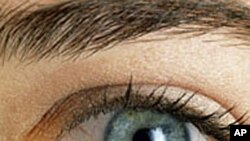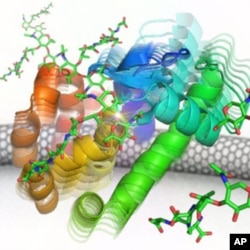California scientists attached a tiny electric circuit to a protein in the human teardrop and watched it destroy invading germs.
The unique experiment, a marriage of nanotechnology and microbiology, could lead to new ways of diagnosing cancers and other illnesses in their very early stages.
About a hundred years ago, a Scottish biologist discovered that proteins called lysozymes in human tears can kill bacteria. Scientists have studied the enzyme extensively, but molecular biologist Gregory Weiss at the University of California, Irvine set out to learn more.
“What we didn’t know is that once the enzyme latches on to the side of the cell wall of the bacteria," he says, "it eats all the way across the bacteria without letting go.”
The tiny lysozyme breaks down the cell wall of the much bigger bacterium. Associate physics professor and collaborator Philip Collins says the scientists designed a way to study that by "listening in on a molecule."
Collins and Weiss assembled columns of carbon atoms called nanotubes into a tiny transistor - an electronic switch that regulates current, just like what you’d find in a computer or a smart phone. Then, Weiss says, they attached it to a single lysozyme molecule.
“The carbon nanotube is conducting electricity and as the enzyme starts going about its motion, as it starts chewing on the walls of bacteria, it changes the conductance and flow of electrons through the carbon nanotube.”
Collins says the nanotubes are the world’s smallest wires. “You might think of our wiring as being a tiny microphone, that’s so small that we can reach and tap into the signal from a single molecule.”
Weiss and Collins recorded the signals, and say the data confirmed what is already known about the enzyme.
In addition Weiss says, they observed it in different chemical environments. “Our technique allows us to see that. [In] previous techniques, reporter molecules would fade and prevent you from watching it for long periods of time. Whereas our technique lets us watch for a really long period of time.”
Collins says the work is “expanding the envelope to where these circuits can be thought of, not just as transistors or memory, but as real tools for doing new science.”
Weiss adds that the research, published this week in Science, could lead to improvements in medical diagnostics.
“The system we’re describing in this paper is amazingly sensitive. And so, we think that we can drive this to the point of being able to look for single individual molecules associated with cancer,” Weiss says. "That means cancer or chronic illnesses could be detected very early and treated with better outcomes.”







